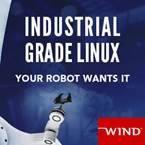Increasingly robots help maintain the structural health and integrity of our buildings and infrastructure, inspecting and repairing bridges, dams, skyscrapers, you name it, in order to keep people safe and make the world more efficient.

How Robots Are Used to Improve Structural Health and Design

How Robots Are Used to Improve Structural Health and Design
Article from | Jori Hamilton
Robotics is being utilized by every industry to improve lives and business processes, but what about the world outside factories and offices? Increasingly robots help maintain the structural health and integrity of our buildings and infrastructure, inspecting and repairing bridges, dams, skyscrapers, you name it, in order to keep people safe and make the world more efficient.
Robotics fills needs where human labor is dangerous, hard to come by, or expensive, and in many ways, this is making the world safer for all of us. Through their ability to go where humans cannot and manage predictive maintenance, robots are giving humans hope for a better, safer tomorrow.
But you may be asking yourself, why robots? How can a robot improve structural health?
Why Robots?
Inspecting the structural integrity of a building or resource is not always easy. Whenever that structure has foundations underwater or is of a size and scale that makes human navigation difficult, conducting an inspection of the structure is difficult at best and life-threatening at worst.
Take, for example, the piers and bridges pf Manhattan. In order to make inspections of them safer, there are AI-powered robots being built by researchers at Stevens Institute of Technology. These robots are being programmed with reinforcement learning, a form of AI that learns from repeated data sets in order to adjust to the rapidly changing environment beneath the sea and conduct thorough inspections and maintenance of US bridges, piers, pipelines, and dams. As our infrastructure begins to fail, this technology will be vital to maintaining a functioning economy.
Underwater infrastructure is another vital component of the nation that is commonly at risk. In the hard-battered environment of the sea, structures can quickly lose integrity. The worst part is, inspection of these structures is exceedingly difficult and expensive. For divers to reach depths often needed to conduct complete inspections of this infrastructure, they often have to place their lives at risk. It can take weeks for a diver to recover from reaching a dangerous depth.
Similarly, buildings that rise high off the ground or mines that delve beneath the earth make for dangerous environments that humans cannot easily access. Predictive maintenance models can assist inspectors in finding problems, but robots can do even more.
From tracking down structural damage to building extensive models for improvement, robotics is the next wave of structural health and design.
How Are Robots Improving Structural Health?
Everywhere that a structural environment poses a risk to human life, robots are being built and programmed for exploration and inspection. From nuclear plants to the deep sea, these bots can improve structural health by finding damages, leaks, and problems that humans would never be able to find.
The potential of what robotics can offer structural health and design is limitless, but here are a few of the benefits we are already seeing:
- Better visuals
- Reduced costs
- Reduced human risk
- Better precision with detecting structural shifts
- 3D modeling capabilities
- Greater mobility and agility in previously unreachable areas
- Protection of infrastructure
- Protection of ecosystems
PRENAV’s precision drone system, for example, uses fully automated drones to explore and record the entirety of a structure regardless of its height. Then, using included 3D-modeling software, a complete model of the structure can be recreated and analyzed safely by humans for improved design or any structural faults. This method saves companies hundreds of thousands of dollars in inspection costs alone, not to mention the costs that might occur due to unseen damages.
Additionally, this method saves money. While manual inspections of a large facility can cost hundreds of thousands of dollars, the PRENAV system is only $20,000.
Meanwhile, underwater robots are conducting maintenance and examining structures for improvements. In one instance, fisheries specialist Tom Carlson designed a robotic swimmer to determine where salmon were being injured against a dam. This system allowed the dam’s engineers to improve the design, keeping the mortality rate of the fish down and reducing damage to the ecosystem. Similar robots like those designed by NASA can inspect for leaks and damages, and are invaluable alongside other monitoring tools like weir boxes.
By going where humans cannot go easily, robotics is changing the face of structural safety and design. Robots enable a complete picture and analytic data needed to recommend improvements to the way we build, whether we are building underwater or high above it. Structural engineers can then more accurately plan for, predict, and stave off disasters that would otherwise threaten human life.
A Robotic Future
Robotics like drones and autonomous swimmers can enhance the potential of structural design and safety. With the kind of data and feedback gathered from these invaluable resources, better buildings and resources can be created that stand up to time and the weathering of the elements, be it air or ocean.
With AI-powered robots using combinations of video monitoring, sonar, and motion-sensing software, robotics can help to save millions of dollars and plenty of human lives in the upkeep of our infrastructure. Better inspections, more data, and reduced costs mean a safer future with the power of robotics.
The content & opinions in this article are the author’s and do not necessarily represent the views of RoboticsTomorrow
Comments (0)
This post does not have any comments. Be the first to leave a comment below.
Featured Product

Wind River Linux - An Industrial Grade Linux
Build and deploy robust, reliable, and secure Linux-based robotic systems without the risk and development effort associated with roll-your-own (RYO) in-house efforts. With Wind River Linux get the industry’s most advanced embedded Linux development platform, with a comprehensive suite of products, tools, and lifecycle services to help robotic manufacturers build the next-gen robotic systems. Your robot wants it!